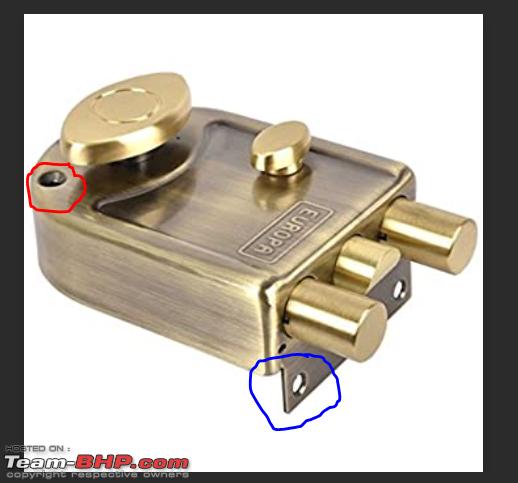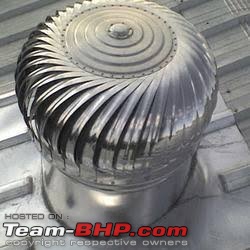Team-BHP
(
https://www.team-bhp.com/forum/)
Quote:
Originally Posted by Aroy
(Post 4802621)
I have seen similar damage in brand new flats. The main reason is
1. Plaster using inferior sand which has a lot of salt in it.
2. Plastering and subsequently painting walls and ceiling before the walls have dried. This is more so in humid areas and builder built flats where they do not allow time for the walls to dry (In Delhi summers it takes at least 4 days, and I assume that in humid regions it may take upto a month to dry out fully).
|
This seems like a reason. However, are you sure this is not a Condensation mould? The house is situated
near Kolkata, so its as humid as the scales can get. :P
We had got a "treatment" done which was initially suggested by the builder-friend, but I guess even that was a sham as was the original construction.
The main issue was we could not have inspected the initial construction due to its distance from home. Now we're repenting.
Any specific treatment I should ask agencies to do, so that I am assured I am not losing out again? I'll definitely go with an outside agency instead of relying on the in-house builder for convenience's sake.
Additionally, is there any way to check the sand for saltiness? I'd like to be aware of the same in any future endeavours.
Quote:
Originally Posted by sharktale
(Post 4802680)
This seems like a reason. However, are you sure this is not a Condensation mould? The house is situated near Kolkata, so its as humid as the scales can get. :P
We had got a "treatment" done which was initially suggested by the builder-friend, but I guess even that was a sham as was the original construction.
The main issue was we could not have inspected the initial construction due to its distance from home. Now we're repenting.
Any specific treatment I should ask agencies to do, so that I am assured I am not losing out again? I'll definitely go with an outside agency instead of relying on the in-house builder for convenience's sake.
Additionally, is there any way to check the sand for saltiness? I'd like to be aware of the same in any future endeavours.
|
What is done is done. You have to dry the walls thoroughly any way before taking any other remedial action.
1. The salt in the plaster takes time to come out, but I guess that if the flat is over a year old most of it has come out.
2. The salt will seep out and form crystalline patches. If they are no longer visible, then it is fine.
3. Any way you have to scrape the walls of the existing paint.
4. If you can wait a year it is best to paint the walls and ceiling with age old lime "white wash". Not only will it neutralise any acids in the plaster, but it is cheap and a very good inhibitor of mould.
You can repaint with other paints after a year or two. That will give you time to rectify any leaks (that are a regular feature of builder built flats) and seepages.
Some of the screws holding my main door have become separated from the door, and are hanging loose. Attaching a picture for reference.

How did it happen? The door was open, and closed with a bang due to wind. The screws marked in red are no longer attached to the door. Currently, the lock is hanging on, thanks to the screws marked in blue.
My first instinct was to hunt for a longer screw, but could not find anything matching the thickness in any nearby shop. I think the screws on its way out might have made the hole holding the screws bigger, so that it is currently not able to hold the screws.
Quote:
Originally Posted by KL01toKA03
(Post 4806626)
Some of the screws holding my main door have become separated from the door, and are hanging loose. Attaching a picture for reference. Attachment 2007033
........
|
The material (wood) of the door is screw unfriendly. That is the fibres are hard and closely packed together and have no give in them.
Traditionally the screws and nails put in wood retain their position due to the fact that they push the fibres apart when inserted and once inserted wood presses back. Most softwoods have this property, so do some hardwoods, teak primarily. Most of the cheaper hardwoods and MDF do not have this property and with time the screws get loose. One of my doors is made from such inferior wood and the screws of the door handle keep coming loose. The only method that I could think of and use is to insert a match stick or an agarbatti stick in the hole and screw the screw back. Does its job for six months and then the screws become loose - another round of sticks.
This is one of the reasons that I advocate against drilling pilot holes in wood to fix screws (I use a nail which just pushes the fibres not cut them. If the screw cannot force itself into the wood then the wood is not suitable and the screw will work loose.
You can use some wood glue - fevicol or its equivalent when inserting sticks in the hole, that will increase the time before they come loose.
Quote:
Originally Posted by Aroy
(Post 4806652)
You can use some wood glue - fevicol or its equivalent when inserting sticks in the hole, that will increase the time before they come loose.
|
Thanks for the suggestion. What are your thoughts about a using wooden wall plugs instead of matchsticks?
Anyone here tried wind turbine ventilation fan in roof in residential building ?
I am thinking of putting one in skylight area in staircase roof shaft to prevent heat pocket formation.This will be highest point in home and is connected to all indoor common areas and rooms.
Any precautions and considerations for size etc ?
Pictures for reference from net


Quote:
Originally Posted by KL01toKA03
(Post 4806706)
Thanks for the suggestion. What are your thoughts about a using wooden wall plugs instead of matchsticks?
|
What I do when fixing locks and latches to main doors is that I put araldite in the holes before putting in the screws. Then also apply some araldite on the screws before putting them in. This helps a lot in giving a strong and durable hold if you’re sure that you won’t need to unscrew them in near future.
Regards.
Quote:
Originally Posted by KL01toKA03
(Post 4806706)
Thanks for the suggestion. What are your thoughts about a using wooden wall plugs instead of matchsticks?
|
Softwood of matchsticks is ideal as it will compress and expand. Any way you need a thin piece as the hole is just a tiny bit bigger than the screw. In case one does not do the job put two.
Quote:
Originally Posted by saket77
(Post 4806853)
What I do when fixing locks and latches to main doors is that I put araldite in the holes before putting in the screws. Then also apply some araldite on the screws before putting them in. This helps a lot in giving a strong and durable hold if you’re sure that you won’t need to unscrew them in near future.
Regards.
|
Araldite will will become hard and solid and that may not solve the problem of hard wood slowly receding and working the plug loose again. I have found that if you have to use epoxy, then it is best to use at least 50% filler, in this case saw dust which make the bond stronger. A rubber solution or Fevicol is better suited for wood than epoxy.
Quote:
Originally Posted by KL01toKA03
(Post 4806626)
Some of the screws holding my main door have become separated from the door, and are hanging loose. Attaching a picture for reference. Attachment 2007033
How did it happen? The door was open, and closed with a bang due to wind. The screws marked in red are no longer attached to the door. Currently, the lock is hanging on, thanks to the screws marked in blue.
My first instinct was to hunt for a longer screw, but could not find anything matching the thickness in any nearby shop. I think the screws on its way out might have made the hole holding the screws bigger, so that it is currently not able to hold the screws.
|
If its a Europa lock as shown in the picture, you can call their customer support and they will send their local technician to fix it (I think free of cost depending on the number of years).
I use a good quality wood filler (procure it from overseas, Indian ones are no good) It hardens like rock, then drill
Quote:
Originally Posted by KL01toKA03
(Post 4806626)
My first instinct was to hunt for a longer screw, but could not find anything matching the thickness in any nearby shop. I think the screws on its way out might have made the hole holding the screws bigger, so that it is currently not able to hold the screws.
|
Quote:
Originally Posted by sanjaykk
(Post 4807003)
If its a Europa lock as shown in the picture, you can call their customer support and they will send their local technician to fix it (I think free of cost depending on the number of years).
|
I have done this, though it was not easy finding a number that someone answered.
Quote:
Originally Posted by KL01toKA03
(Post 4806626)
My first instinct was to hunt for a longer screw, but could not find anything matching the thickness in any nearby shop. I think the screws on its way out might have made the hole holding the screws bigger, so that it is currently not able to hold the screws.
|
Go for oversize screws - next higher diameter
http://www.youtube.com/watch?v=mIM5QwYVStU
Has anyone had experience doing something like the above? ie add columns to support the floors above while the ground floor will still be load bearing?
This would not actually do good to the external aesthetics of the building but I think that can be managed.
I guess we will need plinth bean at the ground level to prevent differential settlement. Can this plinth beam just connect all columns through the outer perimeter of the house? There will be two columns inside of the house as well. To do the plinth inside the house the flooring has to be redone and we have to dismantle some of the walls. So is it safe to leave that out and just it connect the outer columns?
The house is 22ft x 38ft and around 800sq ft.
Also does this type of construction where the columns are built outside of the walls have any disadvantages in general?
Quote:
Originally Posted by prasanth
(Post 4807751)
[url].......
Has anyone had experience doing something like the above? ie add columns to support the floors above while the ground floor will still be load bearing?
This would not actually do good to the external aesthetics of the building but I think that can be managed.
I guess we will need plinth bean at the ground level to prevent differential settlement. Can this plinth beam just connect all columns through the outer perimeter of the house? There will be two columns inside of the house as well. To do the plinth inside the house the flooring has to be redone and we have to dismantle some of the walls. So is it safe to leave that out and just it connect the outer columns?
The house is 22ft x 38ft and around 800sq ft.
Also does this type of construction where the columns are built outside of the walls have any disadvantages in general?
|
My inlaws did just that. They had a 2 story house with built up area of 1200 sq.ft. With new bylaws they could increase it to 1800, but did not want to disturb the current construction when they wanted to raise the house to four floors.
So they got the design done for a 5 story frame with columns at each corner and at centre of each side, with a couple in the centre. The engineer designed the columns so that they would support each existing floors roof slab properly. Beams on the periphery supported the old roof slabs, while the columns at the centre did the rest.
The only problem is to be careful while digging the foundations.
1. The existing brick foundation at the corners extend at least 4 feet, so they have to be cut and new footings made, just support the existing roof on a lot of support poles.
2. When casting beams for the ground floor, they did a unique thing. First they filled the form work with concrete and vibrated it. Then they raised the form work to ensure that there was no gap between the top of the cast beam and the roof slab. This is especially important as any gap may result in the roof slab settling at a later stage.
A peripheral beam at the plinth level is rarely needed. Unless the soil has very low bearing capacity there is little chance of the new and the old foundations settling, let alone settling differential. Of course in case of a sever earthquake it may happen, but you have to live with it if you want to retain the existing brick load bearing wall structure.
Quote:
Originally Posted by Aroy
(Post 4807977)
My inlaws did just that. They had a 2 story house with built up area of 1200 sq.ft. With new bylaws they could increase it to 1800, but did not want to disturb the current construction when they wanted to raise the house to four floors.
So they got the design done for a 5 story frame with columns at each corner and at centre of each side, with a couple in the centre. The engineer designed the columns so that they would support each existing floors roof slab properly. Beams on the periphery supported the old roof slabs, while the columns at the centre did the rest.
The only problem is to be careful while digging the foundations.
1. The existing brick foundation at the corners extend at least 4 feet, so they have to be cut and new footings made, just support the existing roof on a lot of support poles.
2. When casting beams for the ground floor, they did a unique thing. First they filled the form work with concrete and vibrated it. Then they raised the form work to ensure that there was no gap between the top of the cast beam and the roof slab. This is especially important as any gap may result in the roof slab settling at a later stage.
A peripheral beam at the plinth level is rarely needed. Unless the soil has very low bearing capacity there is little chance of the new and the old foundations settling, let alone settling differential. Of course in case of a sever earthquake it may happen, but you have to live with it if you want to retain the existing brick load bearing wall structure.
|
Thanks a ton. So have they cut though the walls and installed the columns or have they added the columns outside of the house without cutting the walls?
Regarding the columns inside the house: Do they have any beams connected to them on the floors below? Or are they just used with tie beams on the new floors?
Regarding the plinth beam is it any good still adding it outside of the building alone to add some additional support?
| All times are GMT +5.5. The time now is 01:51. | |




